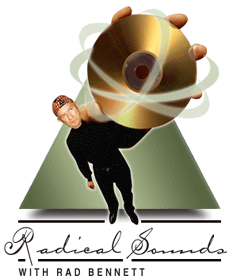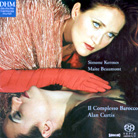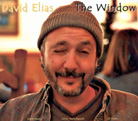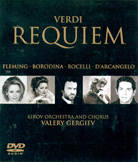 |
| April 1, 2004  Radical
Sounds: MDG -- A Different Approach to Multichannel Radical
Sounds: MDG -- A Different Approach to Multichannel
Thoroughly impressed by the first MDG DVD-Audio releases, I talked with Werner Dabringhaus, managing partner of the company Dabringhaus und Grimm Audiovision GmbH, which produces the discs. Rad Bennett: I have admired MDG recordings from the first time I heard one of your regular CDs. The sound seemed close-up and clear, with a tremendous sense of presence, yet warm and very natural. How did you achieve that rare combination of pluses in making stereo recordings? Werner Dabringhaus: Thank you for the compliment. You have exactly described our sound philosophy: As much natural atmosphere as possible and a sound presence that would allow you -- if possible -- to write the score down. The most important part is the choice of the recording hall. You know that we will never make a recording in a sterile studio atmosphere. Today, the technical possibilities to add the finest reverbs to a rather dry recording are phenomenal, but no artist would like to perform in such an acoustic. Normally they are playing with and within the acoustic, they form their next sounds from the sound they just heard in the hall, and thus you can have a very realistic and logical interpretation that is in close harmony with the natural sounds from the instrument(s) and the room. In reality, the composers themselves reacted [to] the acoustics of their halls. You may detect it from the scores of Haydn symphonies. Those composed in Esterházy have rather short general pauses -- they are to be performed in a chamber-music hall. But look at the "London" symphonies, which had been composed for a church acoustic. Here you find general pauses of more than one bar. Can you imagine this in a dry acoustic? This is a very important detail in the score, which helps us to find the right acoustic for a recording. Or think of G.F. Handel: When he wanted to perform another oratorio (as always, at [his] own expense), a friend said, "Oh, we sold so few tickets that the audience may dance in the hall." He answered, "In that case, the sound of my music will be much better . . . " The composers knew a lot of the acoustical phenomena, and we should consider it when starting a recording. RB: I continue to be impressed with your recordings of various organs. What special problems and solutions are involved in recording "the King of Instruments"? WD: The organ is not only a very complex instrument in itself; the main task of the organ builder is to implement the instrument in the appropriate acoustic. Thus, you have a very close relationship between the architecture of a church or cathedral and the sound from the organ. The old Roman-style churches have a big bass boost, in contrary to the later, Baroque ones, which are rather clear -- thus you find big reverberation in French cathedrals, or very smooth private acoustics in a small countryside church in the southeast of Germany, where a rather unknown Protestant composer named J.S. Bach performed some unknown pieces. Here it is again evident [that you should] record the instrument in its own appropriate atmosphere. The recording should show the architecture of the instrument and the sound of the church in which it was constructed and installed by the organ builder. The next consequence is that the composers always reacted [to] the sounds: thus, romantic French organ music has to be recorded in a French cathedral. And if you hear the fantastic Cavaille-Coll organ in St. Ouen, in France, which was played by Widor himself and -- a miracle -- has never been restored in 100 years, this is a marvelous sound in a big Gothic cathedral with nearly 15 seconds of reverberation! I'm very happy to have the opportunity to record this fine music at this authentic place -- not to forget the fantastic organ player, Ben van Oosten. RB: Yes, I have heard that recording, and it is almost like being in that huge space. Now, you have been quick to embrace the new multichannel possibilities of the high-resolution formats, having just released some dozen DVD-Audio recordings. Why did you decide on DVD-A instead of SACD, and what new challenges and opportunities do these recordings represent? WD: MDG was the first label to present DVD-A -- it was in July 2000, in Japan only, where we released Mozart K. 403, 404, 405, performed by Orchestre de chambre de Lausanne and pianist-conductor Christian Zacharias; and the Concertos for flute, clarinet, and orchestra by an unknown composer named Antonio Cartellieri. This is truly fascinating Bohemian music performed by Dieter Klöcker and the Czech Philharmonic Orchestra. Then we learned that these DVD-A discs were the first in the world. The reason might have been that the major companies did not want to start without copy protection. At those times, SACD tried to come up with stereo in high-resolution only -- this was impressive compared to CD quality. But most of the audience simply was more impressed by Dolby Surround (which may be ideal for cinema purposes but in reality it is just the opposite to high resolution). DVD-A started from the first moment onward with multichannel, and today most DVD-As are in multichannel, whereas you may find a great number of SACDs in stereo only. RB: I note that your use of multichannel is different from the configurations used by most producers. You use something called 2+2+2 Recording. What is that, and how can it be compatible with 5.1? You use a height speaker for the ".1" channel, for instance. How can this signal be successfully fed to the .1, or subwoofer, channel of a regular setup? I know that it works, because I have played your multichannel recordings on my 5.1 system with wonderful results, but I’m not sure how it works. WD: A short question -- a short answer? OK, let’s try it and start with mono. It has a great advantage for all listeners because wherever you are sitting in the room, you have the best possible sound, which is fixed in the loudspeaker. With the invention of stereo, we learned to detect some directions in the field in between the two loudspeakers and behind them, but unfortunately, we are forced to sit exactly at the sweet spot. Yes, stereo makes you lonely! In the cinema, nobody can sit at the sweet spot. Now one invented the center in order to fix the voices (dialogue) from the most expensive actors, [which] are always prominent just in the center of the screen. Note: All other sounds are as unstable and unbalanced as before. With the addition of two surrounds for some back events, you have the complete 5.1 system. In cinema, you have a lot of detonations and earthquakes. It is the subwoofer that helps realize these details, and when you are installing a unit at home you will no longer be lonely because you immediately may be forced to start a discussion with your neighbor. You may imagine that you can hardly find a music score that really needs a detonation. Thus, a subwoofer as an effects channel is completely unnecessary for classical music. Did you ever miss a center [channel] in your stereo? An additional mono loudspeaker? We decided that an additional center will not help to complete the natural sound image and, in reality, you can find a lot of the finest multichannel recordings that use four loudspeakers only. Then we had the idea to use the two other channels, which have full frequency response in finest quality for an elevated pair of loudspeakers, [which] could help to transform the natural three-dimensionality of all acoustic phenomena. Now, suddenly, it was possible to position the woodwinds on their own raised platform in the orchestra, above the strings, while the organ is raised above all -- up to 60 feet, in that recording of the Widor Toccata with Ben van Ousted that you can hear on our Dimension DVD-A. We called it 2+2+2 Recording. The fascinating point of the 2+2+2 reproduction is that you need not use but three pairs of loudspeakers, and a standard player and amplifier electronics that you can buy everywhere in the world. And there is another really important effect: Whenever you hear a 2+2+2 Recording you are no longer anchored to the sweet spot, but you enjoy an amazing sense of three-dimensional space and a logical, natural, and stable three-dimensional sonic portrayal of instruments from almost all points within, or even outside, the area defined by the speakers. RB: You point out in your DVD-A notes that one can replay the 2+2+2 Recordings in whatever system one uses at home, be it stereo or 5.1 or 2+2+2. WD: At a first sudden glimpse it seems impossible, because we use the center channel for the elevated left and the .1 channel for the elevated right signal. I will try a rather simple explication. The basis of our multichannel [sound] is the stereo recording, which has all three-dimensional elements in it. Think of an orchestra: You may use two microphones, find the best place in the best possible hall, and you have a good balance of the overall sound. Then you feel there could be a bit more of the ambience -- "why the hell are we recording in such an expensive hall?" With the addition of some distant room microphones, you can give more of the atmosphere to the stereo. Then you feel the woodwinds are at a greater distance from the strings than should be natural: Another pair of microphones helps to balance them -- if they are not too close to the musicians. Therefore, we always elevate these stands in order to get a natural delay for better sound. This is the simple way to start with a stereo recording. For 2+2+2 Recording, we now give the ambience microphones additionally to the surrounds and the woodwind microphones additionally to the elevated loudspeakers. Thus we can exactly balance the elevation of all instruments of the orchestra. (Additionally, we have those very important sound reflections from the ceiling of the hall.) This means: When you switch off the surround and elevated [speakers], you will have the original stereo [recording] as we released it on CD. The main compatibility problem when using a 5.1 system is the subwoofer, which in no case should start to play because it would completely damage our sound image. Thus, we decided to use a smooth high-pass filter for the elevated loudspeakers at very low frequency, which prohibits the sub from moving -- all other frequencies cannot be played by the sub. Why is it possible to have an elevated left signal in the center? Think again of the orchestra. The timpani are in the very center, but elevated maybe up to the cross point of the front loudspeakers. This means from the levels you need 25% on all four loudspeakers. When changing to 5.1, that part played back by the subwoofer will disappear and the other part of the timpani sound will no longer be at elevated left but in the center -- where it belongs. Note: During the final balancing, we are always switching between the different formats. Thus, we are sure that it works. You should try it. RB: Are all of your multichannel recordings originally conceived as such? I suppose it’s possible, given the multi-microphone configurations used in most sessions, to "reconstruct" a multichannel soundfield, but I am never as convinced by such remixings as I am by sessions originally planned for multichannel. WD: Normally, you are right, because 5.1 is quite another principle from stereo or 2+2+2, which basically is a stereophonic system as well. The additional mono makes it quite difficult to come to a compatible miking or mixing. But why then not start with 2+2+2, which does not have any compromise? Unfortunately, the industry started to re-release old-fashioned multichannel recordings instead of presenting the new possibilities with brand-new recordings. This is a fantastic chance for all music-lovers, musicians, and young artists. Actually, we have the chance to re-record the complete repertoire! And have a lot of fun with the music. RB: Your recordings are so exciting, I am sure that all listeners will want more. What's up for 2004? WD: Just [as] at the MIDEM, MDG presented a 2+2+2 Recording of a vesper by Heinrich Schütz, with Peter Neumann and the Cologne Chamber Choir. You know that Schütz was the first to introduce surround sound to Germany -- some 400 years ago. Here we have recorded some extraordinary pieces with different soloists, instruments, orchestras, and choirs truly surrounding the audience: you feel like the contemporary listener at the Dresdner Hofkirche, who must have been completely overwhelmed when hearing his famous "Saul, Saul, was verfolgst Du mich . . . " You can imagine that it was quite complicated to install and balance all musicians at their different balconies. Though these recordings do work quite well in stereo -- if you ever have heard this music in multichannel, you will never want to hear it in stereo again. Then we can announce a first original composition in 2+2+2 technique: AquaAngelusVox is a three-dimensional sound composition by Schäfer//Krebs, a couple of artists who have been presenting this kind of room installation for 15 years now and who have been inspired by the opportunities offered by 2+2+2. There will be a complete edition of all the Shostakovich symphonies with the Beethoven Orchester Bonn and their conductor, Roman Kofmann -- Vol. 1, with the 10th symphony, is just being released as a power pack including a DVD-A, and an additional CD to use in your car. There will be another Zacharias recording, and maybe we will have some SACDs, in order to show that 2+2+2 is possible here as well. There are hundreds of ideas, and naturally we will have a lot of fine music on CD as well, because, unfortunately, it seems to take time before most of our audience will have found their way to multichannel and its incredibly more natural music reproduction. RB: Thanks for your time, and my best wishes for every success in recording and marketing your wonderful recordings. More information on MDG and the 2+2+2 recording system is available at: www.mdg.de and www.2plus2plus2.ch. Here are three that made the cut this month:
For those already scurrying to their music dictionaries to find out what this unheard Handel work is, it won’t be found there. This is a pastiche fashioned by mystery author Donna Leon and Baroque music specialist Alan Curtis. The theme is that of an abandoned sorceress, cruelly rejected by her lover, who thus loses her powers and must die a mortal death. Leon and Curtis have compiled this scenario from excerpts from three Handel operas -- Rinaldo, Alcina, and Amadigi -- performed as originally written; it is their juxtaposition that creates the "new" work. Even if you don’t like the new piece created by the reshuffling, you can enjoy a splendid recording of excerpts from Handel’s operas. The singing is first-rate and then some. Soprano Simone Kermes has prodigious technique and a sense of drama that is right on the mark. Some of her pianissimos and shadings might make one gasp in admiration. The small chamber orchestra plays with sure technique and persuasive flair. The recording provides excellent balance, both between soloists and orchestra and within the orchestra itself. The solo voices are clear as the proverbial bell, within an overall acoustic of a reverberant, medium-sized hall. The CD tracks are quite good, but the SACD tracks are more subtle and realistic.
Heartfelt. Heartland. Heartbreak. Honesty. Simplicity. True blue. Sure as an arrow. Right as rain. The real deal. These words and phrases rushed through my head as I listened to this disc. David Elias sings in a voice somewhat reminiscent of Eric Andersen’s, and writes beautiful songs devoid of anything false -- his sincerity as writer and singer shines quietly through. He is backed by some wonderfully subtle virtuoso musicians on dobro, lap steel, mandolin, guitars, drums, double bass, harmonica, accordion, and keyboards. In this age of sound bites and political mudslinging, Elias’s music is refreshing. He doesn’t hit you over the head with it, but seems to say: "Come in, sit a while, and listen. Be at peace within yourself and with everyone else." In tune with Elias’s musical approach is the honest recording. He recorded in live takes, without overdubs or splices. What you hear is what they got, and how wonderful it is. The sound is so natural, especially in the multichannel mixes, that I could swear the performers were right there in my listening room. The Window joins the exalted ranks of John McEuen’s Nitty Gritty Surround and Jorma Kaukonen’s Blue Country Heart as one of the best examples out there of acoustic high-resolution recording.
Verdi’s operatic Requiem is an ideal subject for the high-resolution treatment. Gergiev’s reading is dramatic and forceful. It does not eclipse the versions by Toscanini, Reiner, or Solti, but it does hold one’s attention throughout its 85 minutes. Gergiev built the Kirov chorus and orchestra into something of a modern legend, and knows how to get the most out of his hometown ensembles. The chorus is exceptionally impressive, notably the rock-solid, perfectly in-tune bass section. When the full chorus and orchestra let loose with a vengeance, as in the "Tuba Mirum," one really feels the day of reckoning is at hand. Yet the singers can bring gentle consolation and perfect intonation to softer passages as well. The final chords of the work are a case in point. The quartet of vocal soloists is outstanding. I don’t believe I have ever heard soprano Renée Fleming sing better. She gets all of the complex elements right, be they dramatic, verismo, or lyric. She finds an able partner in mezzo Olga Borodina -- their movements together are mesmerizing. Bass Ildebrando D’Arcangelo is a real discovery for me. He uses his solid, focused voice with great intelligence, and without compromising any passion. The recording is big if a bit blowsy. There’s lots of impressive reverberation in the large-scale passages for chorus and orchestra, but the acoustic of the recording venue, All Hallow’s Church in London, blurs detail a bit. I remember other recordings made at All Hallow’s sounding very much the same. Quieter sections are clean as a whistle while remaining rich and warm. The balance of soloists and chorus is excellent. Though by no means a perfect recording job, this is a very respectable and effective one; in combination with the dynamic performance, it makes for a thrilling listening experience. ...Rad Bennett
Ultra Audio is part of the SoundStage! Network. |
 Handel: La Maga Abbandonata
Handel: La Maga Abbandonata David Elias: The
Window
David Elias: The
Window Verdi: Requiem
Verdi: Requiem